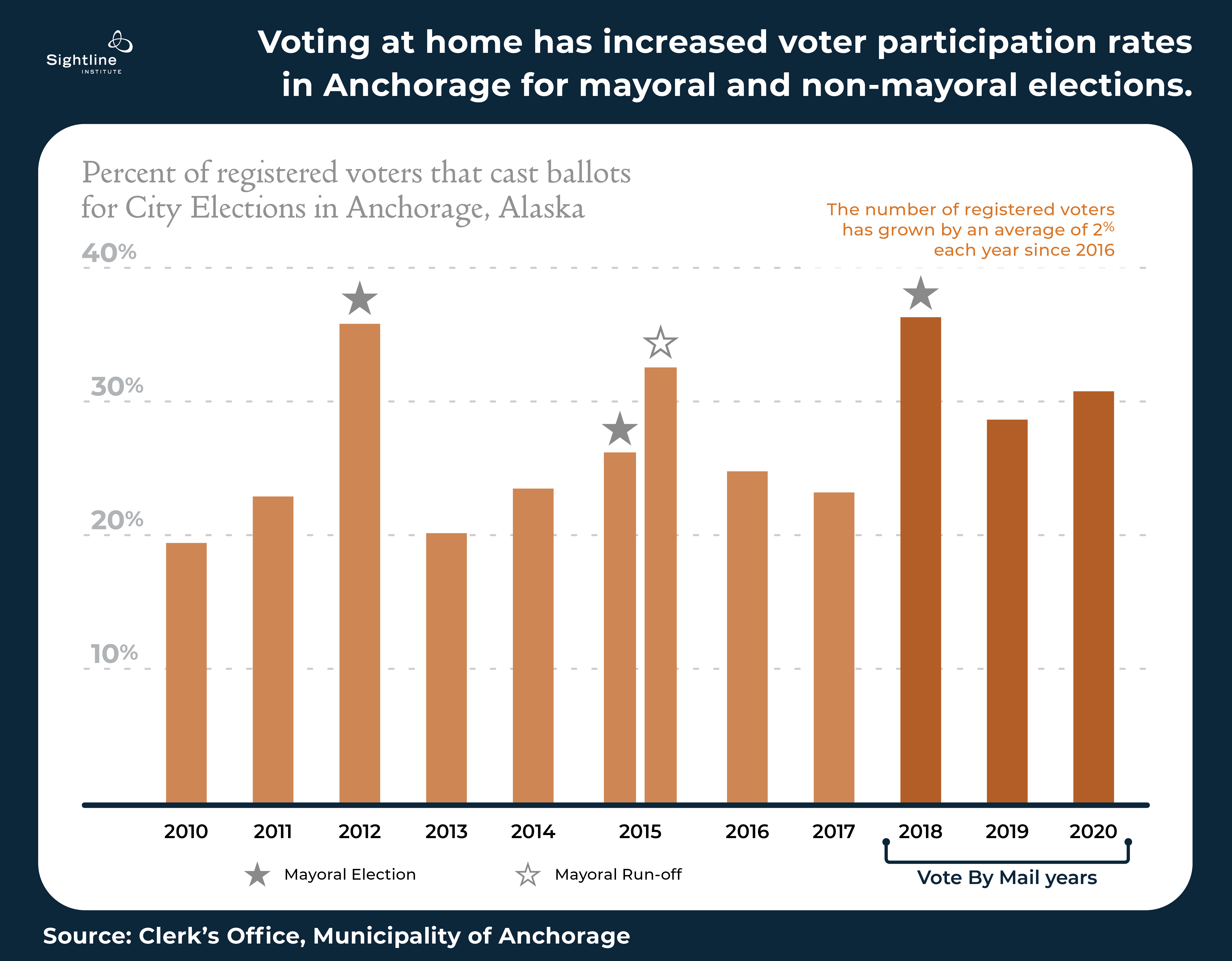In the weeks leading up to Anchorage’s city election in April, nearly all the temporary workers who had signed on to run it opted not to participate. Coronavirus had reached Alaska in mid-March and the city was hunkering down. As is the case across the country, Anchorage’s election workers tend to be older, making them statistically among the most vulnerable to serious complications from COVID-19. For them, staying home took priority. But the city’s Vote By Mail system made for a safe, smooth pandemic election.
Back when Anchorage ran poll-based municipal elections, the city needed 600 temporary workers to set up polling places and machines, check in and assist voters, move machinery and ballots from 122 polling places to a central location, and count votes. On such short notice, finding new workers would have been all but impossible, potentially jeopardizing the timeliness of the election.
With the city’s move to Vote By Mail in 2018, the election team had shrunk to about 60. Replacing them on short notice was stressful, but doable. The municipal clerk’s office, which administers the election, managed to round out the remaining election workers with a largely volunteer group of election worker friends, family, and employees from other city departments. There were just enough people to pick up ballots from drop boxes, count and sort them, check signatures, and personally answer voter questions. With everyone pitching in, Anchorage’s third Vote By Mail election went smoothly in the midst of a pandemic and hunker-down orders.
Vote By Mail empowered Anchorage citizens to securely exercise their basic right without risking their lives. As a bonus, turnout of 31 percent and total participation of 71,382 votes were both high for a non-mayoral election. An alcohol tax, a somewhat controversial school bond measure, and an abundance of time at home may all have contributed to strong interest by voters.

Vote By Mail makes for high turnout and a smooth pandemic election in Anchorage. Original Sightline Institute graphic by Devin Porter of Good Measures, available under our free use policy.
The nonpartisan roots of Vote by Mail in Anchorage
The city’s Vote By Mail program took root in 2014 when Anchorage Assembly member Ernie Hall asked the clerk’s office to research options for increasing lackluster voter turnout in city elections while reducing costs. Hall, a political centrist, also wanted to ease Anchorage’s reliance on the hundreds of paid temporary workers required each year to run poll-based elections. Workers tend to be near retirement age or older and staffing polling stations could make for long days. The city was having a hard time finding younger replacements with the flexibility to take on a short-lived but intense job for a few weeks leading up to an election.
The exploratory phase, led by Hall, took place during the administration of Republican Mayor Dan Sullivan (no relation to Alaska’s US Senator Dan Sullivan). Findings from the clerk’s office and input from a community advisory group led to a 2016 ordinance by the Anchorage Assembly establishing Vote By Mail as the method of choice for municipal elections. The 9-2 vote earned bipartisan support, including “yes” votes from Bill Starr, representing the conservative district of Chugiak/Eagle River, Jennifer Johnston, now a Republican member of the Alaska House of Representatives, and Elvi Gray-Jackson, now a Democrat in the Alaska Senate.
Over the course of the project, the community advisory group grew to include more than 50 organizations and individuals representing a cross-section of constituencies in Anchorage: the League of Women Voters, AFL-CIO, First Alaskans Institute, NAACP, Anchorage Faith and Action Congregations Together, Randy Ruedrich (the former head of the Alaska Republican Party), and community members. The stakeholders formed four subcommittees to help advise the clerk’s office on technology, education and outreach, procedures, and accessibility.
To meet the timeline laid out by the Assembly, the clerk’s office hired Resource Data, Inc., a local technology company with longtime clients in government and the oil and gas industry to lead the project. Resource Data’s project manager, Dennis Wheeler, had served as Anchorage’s municipal attorney under Mayor Sullivan. Municipal Clerk Barbara Jones, Deputy Clerk Amanda Moser, and Resource Data formed the core of Anchorage’s vote by mail team, with significant involvement by Alaska’s Division of Elections and the city’s geographic information systems team. Wheeler and the Resource Data team interviewed election officials and stakeholders to understand exactly how the system would need to work. They wrote the requests for proposals that would underpin the competitive bidding process for Vote By Mail equipment vendors. Wheeler also led the drafting of all changes to city code required to implement Vote By Mail.
Securing the Anchorage Election Center
At the same time, the city’s election headquarters had long outgrown its space, forcing election officials to run poll-based elections from several different conference rooms on multiple floors of City Hall. The set-up meant election workers were constantly moving confidential information between rooms, posing a risk to security.
The Vote By Mail team embarked on a search for new space. Their list of must-haves included a large, open layout that could accommodate anyone who wished to observe the process while also maintaining voter privacy and ballot security.
They ultimately chose a former ConocoPhillips building in the industrial Ship Creek area north of downtown for a new Election Center. In late 2016, the Anchorage Assembly began leasing the 13,000+ square-foot warehouse. Renovations, including painting, flooring installation, and new wiring began.
The team divided the Election Center into three sections:
- Envelope Processing. Here, election workers feed envelopes through the mail sorter and perform signature verification. The review and resolution team works in this section to address irregular ballots and other issues.
- Envelope Opening. A machine slices open the ballots. Three election workers sit at a table and pull the security sleeve from each envelope. They ensure each envelope is empty and place it in a vault. They also separate each ballot from the security sleeve and put the voted ballot into a locked, but transparent, “cage” on the floor of the Election Center that’s only accessible to election worker team leads.
- Ballot Tabulation. Election workers feed the ballots from the secure cage in the envelope opening section through a high-speed scanner that sends ballot information to a secure server.
Anti-fraud and ballot security measures
Anchorage’s Vote By Mail team began researching ways to protect against voter fraud, lost ballots, and other security issues while efficiently processing ballots. Following the research phase, the team created three requests for proposals (RFPs) for printing and outbound mailing services; inbound mail and signature verification; and ballot scanning and tabulation. They selected vendors who provided the following technologies and processes for a secure vote by mail system in Anchorage:
Intelligent mail barcodes. Voters place the ballot into the security sleeve and seal both in a provided return envelope. Each return ballot envelope has a unique barcode and ID number linked to the voter, ensuring election workers can track precisely who has voted, but not how they voted. The barcode and ID system prevents any voter from submitting more than one ballot. The city may add a tracking system using the barcodes in 2021 so voters can track their ballots from a drop box or post office to the election center in the same way packages are tracked through the mail.
Signature verification. Voters must sign the ballot return envelope. If a disability prevents them from signing their name, they mark the envelope with an X in the presence of a witness. To verify that each voter signature is legitimate and matches with the correct registered voter, teams of two election workers compare them to signatures from prior election poll books, the Department of Motor Vehicles, Permanent Fund Dividend, and other state agencies. If the signature matches with the voter signature on file, workers move the ballot return envelope to the next stage. If the signatures appear not to match, the city gives voters up to 10 days after the election to “cure” the signature on the ballot return envelope by providing another signature and possibly a copy of ID. Officials process all successfully cured ballot return envelopes through the scanning and tabulation system and add them to the ballot count. Election workers have undergone signature verification training from the Washington State Patrol.
Anchorage had retained old poll books containing voter signatures from previous elections. Those signatures would be used to verify voter identities in the new Vote By Mail system, but election workers would not have time to page through the paper poll books for every ballot envelope that came in. Resource Data wrote an application that scanned the poll books and automatically fed digitized signatures into a database that election workers could use instead. Should the state decide to move to Vote By Mail in 2020, it could use this established signature database for Anchorage, home to 40 percent of Alaska’s registered voters.
This process was successful in Anchorage’s first vote by election in 2018. Of the more than 71,000 votes cast, the vote by mail system challenged 1,062 of them for reasons including mismatched signatures, failure to sign the ballot envelope, and post-election postmark dates. About half of the challenged ballots were cured, meaning the voter fixed the problem and their vote was counted. The Election Commission reviewed and rejected three duplicate ballots and just 13 ballots whose envelopes had been voted by someone other than the voter. For example, three ballot envelopes came in without signatures because the voter had another party fill it out for them over the phone or FaceTime. Nine other ballot envelopes had been marked as voted by power of attorney, which is prohibited.
Secure in-person drop off options. Voters in 2020 could return their ballots via the US Postal Service or personally deposit them in any of 18 Laserfab Vote Armor drop boxes throughout Anchorage. Election officials placed the drop boxes at schools, libraries, law enforcement facilities, and other government-owned locations with good lighting, exposure to vehicles and pedestrians, and security cameras. The Anchorage Vote Center at City Hall also housed a drop box.
Transparent process. To give the public full visibility into the ballot-counting process, members of the public can tour the Election Center during the ballot counting process using a designated pathway through the facility.
Other security measures include the following:
- Election workers separate all identifying voter information from the ballots.
- Security cameras detect and record movement in ballot processing areas.
- Two election workers accompany ballots at all times during processing.
- Computers and servers hosting sensitive data have no Internet connectivity.
- Only election team leads can enter the locked cages protecting the servers.
- Cell phones are not allowed on the Election Center floor.
- Every person in the center wears a lanyard, with colors indicating their level of access to the floor.
- No blue or black pens are allowed near the ballots.
Smooth results—even in this pandemic election
Turnout for the city’s first Vote By Mail election in 2018 topped 36 percent, the highest for any election in the last 15 years. Participation rates can partly be explained by high-profile ballot propositions and a mayoral race, which always draws more voters than non-mayoral years. Ballot propositions included a controversial “bathroom bill” that would have reversed parts of a 2015 anti-discrimination law and mandated people use public restrooms according to their biological sex at birth. Voters also considered seven bond measures, a proposal to sell the city’s electric utility, and expansion of property tax exemptions. In two subsequent non-mayoral elections, turnout percentages and the total number of voters were markedly higher than they had been in every non-mayoral election year since 2010.
The high turnout of the Vote By Mail years has coincided with historically high voter registration numbers. In 2016, Alaska voters approved a ballot measure to register eligible applicants to vote or update existing voter registration information using the information provided when applying for a Permanent Fund Dividend (PFD) unless the applicant opts out. Even with a larger pool of registered voters, the proportion of registered voters who actually vote has also increased.
Vote By Mail elections are attractive because they tend to cost less than poll-based elections.

Vote By Mail elections are attractive because they tend to cost less than poll-based elections. But operational expenses for Anchorage’s rose from $713,000 in 2015 to $1.1 million in 2018 for several reasons:
- The city had to move the Election Center from City Hall to a leased building and remodel the space. The move likely would have occurred anyway had the city retained its poll-based system because of space constraints at City Hall.
- Printing costs rose during the first vote by mail election because the Clerk’s Office deliberately printed extra envelopes and ballots and hired a higher number of staff as safeguards for any unanticipated problems.
- The city previously borrowed equipment from the state for poll-based elections. Vote by mail required the purchase of new equipment that the city owns. The new equipment will serve the city for at least a decade.
But in 2020, the cost fell to about $745,000, without startup costs and with a decrease in the number of paid election workers and a better understanding of how many envelopes and ballots to have on hand.
The up-front costs of Anchorage’s vote at home system appear to be justified by the smoothness of the city’s April pandemic election. Ballots arrived in the mailboxes of registered voters a few weeks before election day. Voters took the time they needed to research the issues and fill out their ballots while hunkering down in their homes. City election officials avoided the headaches of extra pandemic precautionary measures while staffing, supplying, and administering in-person polling stations in a municipality the size of Delaware. Irregular voting activity was low. And the election proceeded in full compliance with the CDC’s social distancing recommendations while reaching historically high turnout for a non-mayoral year.
Note: Jeannette Lee is a former employee of Resource Data. Sightline is pleased to welcome her as a senior researcher based Anchorage, Alaska, and focused on democracy and housing affordability.











Jessica W.
Fantastic write up of a job well done. Kudos to Barbara and her team!
Bonnie L Jack
Great article. Loved the detail and made Voting by Mail totally understandable. Thank you.
Cindy Allred
An article on Anchorage’s Vote By Mail.